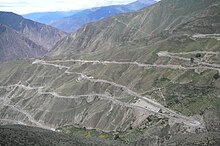Hengduan Mountains
| Hengduan Mountains | |
|---|---|
Burma | |
| Range coordinates | 27°30′N 99°00′E / 27.5°N 99°E |



The Hengduan Mountains (
The Hengduan Mountains cover much of western present-day Sichuan province as well as the northwestern portions of Yunnan, the easternmost section of the Tibet Autonomous Region, and touching upon parts of southern Qinghai. Additionally, some parts of eastern Kachin State in neighbouring Myanmar are considered part of the Hengduan group. The Hengduan Mountains are approximately 900 kilometres (560 mi) long, stretching from 33°N to 25°N. Depending on extent of the definition, the Hengduan Mountains are also approximately 400 kilometres (250 mi) wide under the narrowest definition, ranging from 98°E to 102°E. The area covered by these ranges roughly corresponds with the Tibetan region known as Kham.
The
Geography

The Hengduan Mountain system consists of many component mountain ranges, most of which run roughly north to south. These mountain ranges, in turn, can be further divided into various subranges. The component ranges of the Hengduan are separated by deep river valleys that channel the waters of many of Southeast Asia's great rivers.[1] The core of the Hengduan Mountains can be divided into four major component ranges, described below.[2]
- The westernmost primary range of the Hengduan runs north-south between the Kawagebo.
- Moving eastward, the next major subsection of the Hengduan Mountains is the range running between the Mekong (Lancang) and Himalayamountains, is Hengduan Mountain's immediate neighbor to its west.
- The third primary component of the Hengduan ranges is the section running between the Yangtze (Jinsha) and Yalong Rivers. This section is known for almost its entire length as the Shaluli Mountains except for the northernmost subrange that is called the Chola Mountains. The highest point of this entire section is the Ge'nyen Massif.
- The easternmost of the Hengduan core ranges is the Dadu River. This range is dominated by Mount Gongga, the highest peak in the entire Hengduan group as well as the highest peak east of the Himalayas.[3]
- In addition to the four core systems, described above, some adjacent ranges are also sometimes included as part of the Hengduan group. To the west, the Gaoligong Mountains form an additional barrier along the Salween's western edge, but are more accurately described as an extension of the Baxoila Range connecting with the eastern Nyenchen Tanglha Mountains across central Tibet. To the east, the Qionglai Mountains and the Min Mountains are sometimes included as part of the Hengduan Mountains as these two ranges form the eastern edges of the Tibetan Plateau.
Ecosystems
The Hengduan Mountains support a range of
The ecoregions that coincide with the Hengduan Mountains are:
- The Southeast Tibet shrub and meadows in the higher elevation and northern parts of the Hengduan
- The Hengduan Mountains subalpine conifer forests in northern Yunnan and western Sichuan parts of the central Hengduan
- The Nujiang Langcang Gorge alpine conifer and mixed forestsalong the westernmost ranges of the Hengduan
- The Qionglai-Minshan conifer forestsin the east parts of the Hengduan along the edge of the Sichuan Basin
- The Yunnan Plateau subtropical evergreen forests at the southern parts of the Hengduan where the mountains transition to the Yungui Plateau
- The Northern Indochina subtropical forests in the Nu Mountains, a southwestern component range of the Hengduan in Yunnan
Additionally, the lowest elevation portions of the Jinsha (Yangtze) River and Nu (Salween) River valleys in the southern Hengduan ranges are classified by the Chinese government as a
The easternmost ranges of the Hengduan are home to the rare and endangered giant panda. Other species native to the mountains are the Chinese yew (Taxus chinensis) and various other rare plants, deer, and primates.
Gallery
-
Hailuogou glacier, slopes of Mount Gongga (Minya Konka), Sichuan province.
-
Mount Jampelyang, Yading range, southwest Sichuan.
-
Chonggu grassland and conifer-clad foothills of Mount Chanadorje, snow-clad in background. Yading range.
-
Lake at foot of Mount Chanadorje, Yading range, southwestern Sichuan.
-
Wooded slopes of Chola Mountains, Sichuan province.
-
Panorama of Ge'nyen massif, Sichuan province.
-
Lijiang, Yunnan province, (only city within Hengduan Shan) dwarfed by Jade Dragon Snow Mountain.
-
Kawagarbo, highest peak of Meili range, Yunnan/Tibet border.
-
Gaoligong range, border of western Yunnan and Myanmar (Burma).
-
Gaoligong railway tunnel, Yunnan / Myanmar.
-
Jagged peaks rising fromYangtze Rivergorge Yunnan province.
-
Trial hydroelectric installation, Salween River gorge, Yunnan province.
-
Valley of the Lancang (upper Mekong) River, Baoshan, Yunnan.
-
Hengduan conifer forests, Dêgê County, northwest of Sichuan province.
See also
References
- National Geographic. Archived from the originalon March 27, 2008. Retrieved 28 June 2015.
- ISBN 9787503141782.
- ^ "Sichuan and Yunnan Provinces". Peaklist. Retrieved 2017-03-12.
- ^ "Nujiang Langcang Gorge alpine conifer and mixed forests". Terrestrial Ecoregions. World Wildlife Fund.
- ^ http://researcharchive.calacademy.org/research/cnhp/glgs/PDF/ChaplinG.2005_opt.pdf Physical Geography of the Gaoligong Shan Area of Southwest China in Relation to Biodiversity
- ISBN 7503120401.















